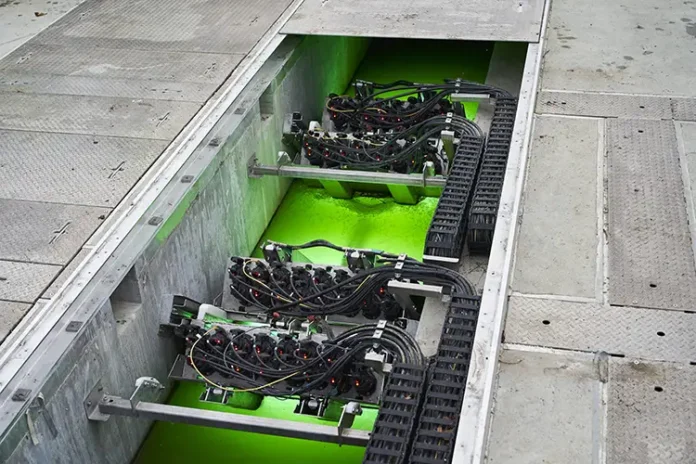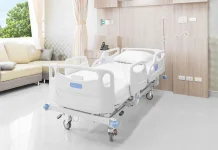Izzy Medeiros, MS Student, Civil and Environmental Engineering, University of New Hampshire, izzy.medeiros@unh.edu
James P. Malley Jr., Ph.D., Editor-in-Chief, UV Solutions and Professor of Civil and Environmental Engineering, Department of Civil and Environmental Engineering, jim.malley@unh.edu
Reaching out to all the contacts on the Qualtrics survey (which totals 45), the following 12 responses are summarized here. The survey pool for healthcare is quite small, with 10 facilities on the contact list, but the respondents (owners) provided interesting perspectives to consider.
Question 1. Please share any observations (whether positive or needing improvements).
-
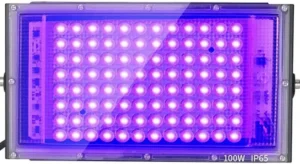
100 W UVC-LED Array for disinfection – SWT Co. Ltd. China (UNH file photo) Three comments from facilities which have UV for room air treatment were similar to this one: “It is good that it is plug-and-play. We turn it on and don’t spend any time climbing up for refilling it or testing it, like taking its temperature, etc.”
- Two respondents indicated they had installed the latest in UV-LEDs for their room air during the worst of the COVID-19 pandemic, and both were questioning if the system was making a difference. One comment was rather specific: “Our maintenance person wonders about the lights, since he says there are about 100 little square chips, and some are brighter than others, while some are completely out after about a year of running it. He thought they were supposed to last a long time.”
- Three responses indicated that the UV systems were added to give their patients more peace of mind and confidence that they would be safe to use the doctor’s office, and it seemed to work well for that purpose.
- Two hospital chains responded that they considered adding UV equipment in key places of their facilities, but the business office came back with the conclusion that they could not make a convincing case for cost vs. benefit of doing so.
- One hospital responded that its chief of infectious diseases was not convinced that “the proposed layout of UV systems with so few devices would result in any significant reduction in HAIs.” The same individual also indicated a general lack of device certification and acceptance by the usual providers of all its medical equipment.
Question 2. If UV technology already is installed or being considered, what questions should be answered?
-
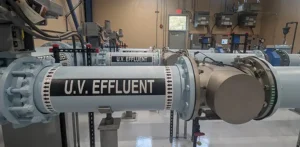
Trojan Swift drinking water UV disinfection system in NH (UNH file photo) Two facilities alluded to this specific question: “Our UV system has been in place for years and works well for meeting our permit coliforms, but we have difficulty with the level of TSS and the decreasing UVT of the water coming into it, especially when our flows are low. How can we make the system work better?”
- All eight respondents that dealt with water asked in one form or another, “Can UV reduce PFAS, and would it be helpful for any other forever chemicals that we do not know about yet but could be coming down the pike?”
- Two water facilities indicated their primary focus is on dealing with lead and meeting new requirements under LCR: “Does UV have anything to do with lead and copper leaching? Can it help, or will it hurt our situation?”
- One interesting comment from a water reuse facility was, “Can anything be done to improve the overall sustainability of our UV system since we have a high electric bill and we have a lot of lamps in operation?”
Question 3. Please add any other thoughts about the UV technologies owned, operated or under consideration?
The following individual quotes were received:
-
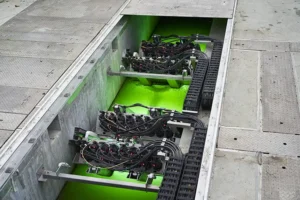
Wastewater UV System in Channel (Courtesy of Trojan Technologies). “When we give tours, we hear a lot that people are glad we don’t use dangerous chemicals anymore for disinfection and we use natural UV, like from the sun.”
- “We really have not thought about it since we put it in last year. All seems to be normal, and we meet out state discharge permit.”
- “We have had sales reps talk to us about replacing our system of lamps with UV-LEDs and saying we could get a fair price. Honestly, we have been disappointed with the LEDs we have in the plant for lighting, since they do not live up to their life – and on several fixtures, at least some LEDs are burnt out! Not sure we would want to take that chance with our disinfection system.”
- “When we went to UV lamps instead of chlor/dechlor, we thought it would be a lot more electricity, but we really do not see any real effects on our bills.”
- “The real benefit of our recent upgrade was the new UV system has a lot less lamps for us to worry about.”
- “During COVID-19, it was important that we do it for our restaurant, but at this point no one is really thinking about it anymore.”


